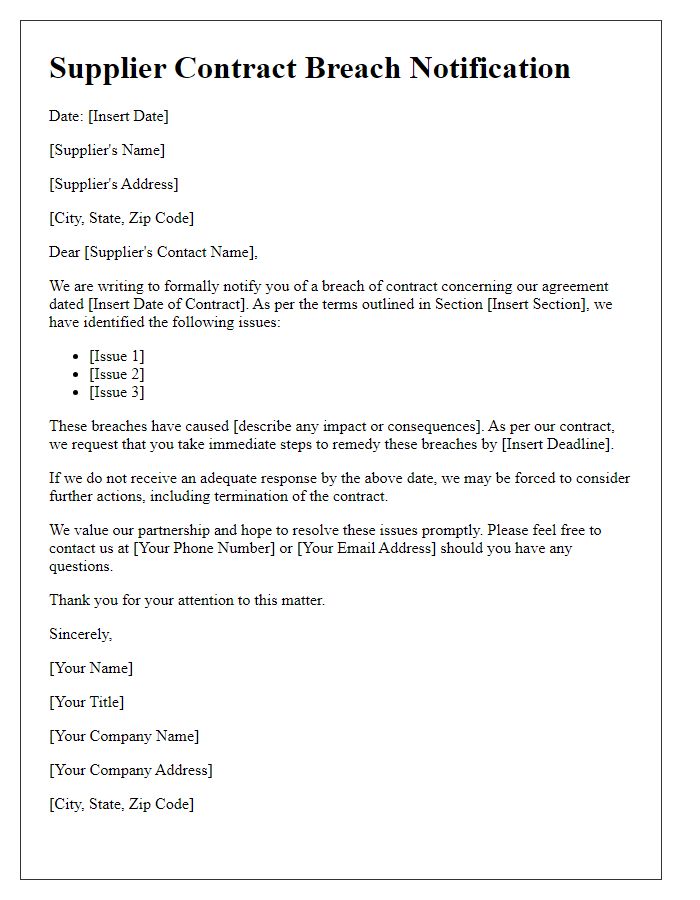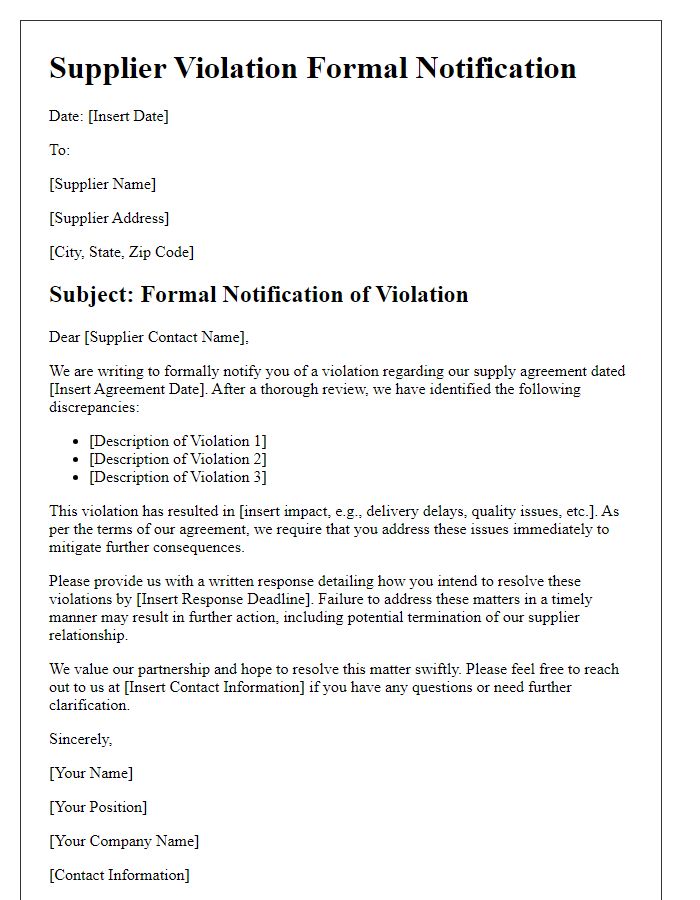Navigating a contract breach can be a tricky situation, especially when it involves a valued supplier. It's essential to maintain open communication, foster collaboration, and aim for a resolution that works for both parties. By addressing the breach promptly and professionally, you can preserve relationships and safeguard future opportunities. Ready to explore effective strategies for resolving supplier contract issues? Let's dive in!

Clear Identification of Breach
A clear identification of contract breach lays the groundwork for effective resolution processes in supplier agreements, often involving specific clauses within legal documents. For instance, non-delivery of goods, such as the recent shipment of electronic components scheduled for October 5, 2023, failing to meet the quality standards outlined in Section 4.2 could signify a substantial breach. Documenting incidents, like the delayed delivery of 500 units of Model X devices, alongside citing the agreed timelines can underscore the severity of the breach. Moreover, properly referencing the governing law stipulated in the contract, such as the laws of New York State, ensures any further action aligns with legal expectations. Detailed records of communication, including the last correspondence on October 10 regarding quality concerns, create a concrete foundation for addressing the breach and pursuing remedies or renegotiations.
Specific Contractual Obligations Referenced
Specific contractual obligations outlined in the supplier agreement establish standards for quality, delivery timelines, and compliance with industry regulations. Instances of breach may include failure to meet agreed-upon delivery schedules, as indicated in Clause 5, and failure to provide products that meet the specified quality standards, referenced in Clause 7. These breaches can result in significant operational disruptions and financial losses, as demonstrated by delays exceeding thirty days from the original delivery date and quality issues leading to rejected shipments. Documentation surrounding communication and corrective actions taken must be reviewed in detail to ensure informed resolution discussions.
Proposed Resolution Actions
When a supplier contract breach occurs, proposed resolution actions may include establishing a clear communication channel to discuss the breach. Assessing the specific terms of the contract, such as delivery timelines, quality standards, or pricing agreements, is crucial. Initiating a meeting with key stakeholders, such as procurement managers and legal advisors, ensures all perspectives are considered. Implementing a corrective action plan, which outlines specific steps the supplier must take to rectify the breach, can help restore compliance. Additionally, setting a timeline for compliance, often within 30 to 60 days, establishes accountability. Regular follow-up meetings to monitor progress and adjustments to the contract terms can facilitate a smoother resolution process. Ultimately, documenting all communications and resolutions ensures transparency and serves as a reference for future interactions.
Timeline for Remedial Actions
Timelines for remedial actions in supplier contract breach resolution are critical for restoring compliance. Specific deadlines for corrective measures should be established, such as a 30-day period for addressing quality control failures in manufacturing processes, particularly for electronics suppliers like those producing circuit boards. Active communication will be essential throughout this timeline, with weekly status updates required to ensure transparency and accountability. Additionally, if a contractual breach involves delivery delays exceeding 14 days, immediate action plans must be formulated to mitigate losses and improve logistics. Implementing these timelines helps rectify issues effectively while maintaining positive supplier relationships and minimizing operational disruptions.
Potential Consequences Outlined
A potential breach of supplier contracts can have significant repercussions for both parties involved. Financial losses may occur if terms are not met, impacting cash flow and profitability. Legal consequences could arise, including litigation costs and potential damages; these scenarios often lead to strained business relationships. Increased scrutiny from stakeholders may surface, resulting in diminished trust and future collaboration prospects. Supply chain disruptions can occur, causing delays in production schedules. These consequences highlight the necessity for clear communication and resolution strategies between suppliers and clients to preserve business integrity and continuity.













Comments